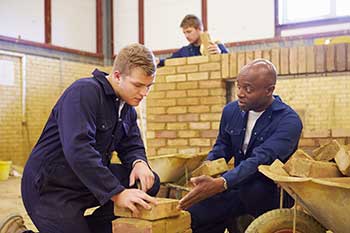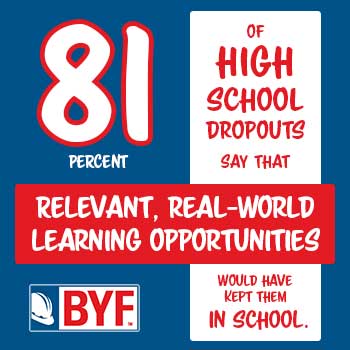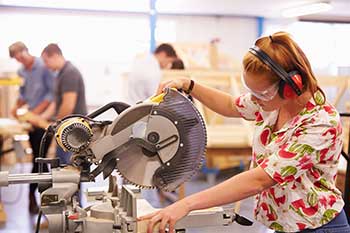Education is always among the most heavily scrutinized areas of our society.
We’re always so concerned about test scores, national and global averages, and getting students ready for college. But in focusing on all those things, we seem to gloss over something pretty basic: The best ways to teach young people skills that they actually need on a daily basis in adult life.
While most of the education world has turned into a textbook-and-lecture format, arguably the best teaching method is much different.
Hands-on education gives students both the freedom and responsibility to learn through real experience, rather than through simply reading or listening to somebody else.
Is hands-on learning better? Here are a few advantages of this more participatory style of education.
Imagine you’re taking a test in history class. To prepare, you look at your notes and re-read your textbook. You take the exam and get a decent score. Great!
But what happens if you take that same exam without revision in 6 months? A year? You’ll likely get a much lower score.
That’s because you didn’t really learn that material. You memorized it for a single purpose and have since forgotten.
Retaining information can be a struggle, and not just over long periods of time as described above. You can be taught something and forget it almost immediately if it doesn’t sink in.
Hands-on learning is proven to be more effective at helping students grasp what they’re taught. There’s no shortage of studies that show hands-on learning has a significant impact:
The reason hands-on learning is so effective at information retention involves both physiological and psychological impacts of the learning style.
Being able to touch and see something is simply more powerful than only reading about it.
Looking at a picture of bacteria doesn’t have as much impact as actually looking at one under a microscope. Watching somebody drill a screw into a board doesn’t compare to feeling the power tool come to life in your own hands.
Too often, getting an “education” means storing tidbits of trivia in your head until the associated exam has passed. Active learning through hands-on projects tosses out the trivia for real lasting experience.

We’ve all been there.
The hour-long lecture is droning on. Your eyes are fighting to stay open. You’re paying less attention to the lesson than you are to the clock, where the minute hand seems to move at a fifth of its normal pace.
One of the top reasons students struggle in school is that they’re bored. It’s not that they can’t comprehend the information or grasp the concepts — it’s that those concepts aren’t being presented in an interesting enough way to care.
It’s easy to understand why sitting still and silent while someone talks at you doesn’t inspire many people.
Hands-on activities bring life back into learning. It gets students up and moving. It gets their blood pumping and their mind revved up. It forces them to listen to instructions so they understand the next step to take or how to overcome a challenge.
It’s much harder to be drowsy when you’re doing something meaningful.
81% of high school dropouts say that relevant, real-world learning opportunities such as those in career and technical education would have kept them in school.
Hands-on learning helps students to not only pay attention, but to actually connect with and enjoy what they learn.

What do you have at the end of a class period that was filled with lecture time? What gets created?
At best, you’ll have some notes jotted down that will get stuffed in a binder or notebook until it’s time to study for the exam.
There’s nothing special about notes. One student’s outline of the lesson might be more detailed than another’s, but at the end of the day, they’re just words on paper or in a digital document.
But when a student leaves a hands-on class at the end of the day, they likely have produced something unique.
For example, carpentry students in a career and technical education (CTE) program create cool projects out of wood. They might make something they can take home like a bird house, a mailbox or a chair. Or they might work collaboratively to build something much bigger, including a real house that someone can live in.
When your learning results in something tangible that you can take pride in — and in some cases, can actually use! — you’re more motivated to come back the next day and continue learning.

Shockingly, young people can change their minds.
It’s tough to choose a career at a young age without ever having experienced the work. Indeed, about a third of college students change their major at least once, and 1 in 10 students change their areas of study multiple times.
It’s always good when someone finally realizes what their passion truly is. Unfortunately, making a 180° spin on your future while paying thousands for tuition can be a costly venture.
Taking more hands-on learning classes in secondary school helps to fix this issue. By having a chance to do actual work, students are better able to understand their strengths, weaknesses, and interests.
Since many students in programs like CTE are still in high school, there’s not a massive financial penalty for trying something, deciding it’s not the right path, and trying something different. Hands-on education is built for experimentation and allowing students to get a real feel for potential careers.
Learning through hands-on methods has a number of advantages over “traditional” education. While it can seem impossible to break away from the lectures and textbooks, programs that rely on hands-on learning might be right under your nose at your local high school.
Among these programs may include career and technical education courses that are built to teach students practical skills that can be applied to a real career. Students are guided by experienced instructors through a number of in-demand crafts, including electrical, welding, HVAC, pipefitting, and masonry.
To learn more about CTE, check out the top 3 reasons you should choose career and technical education.